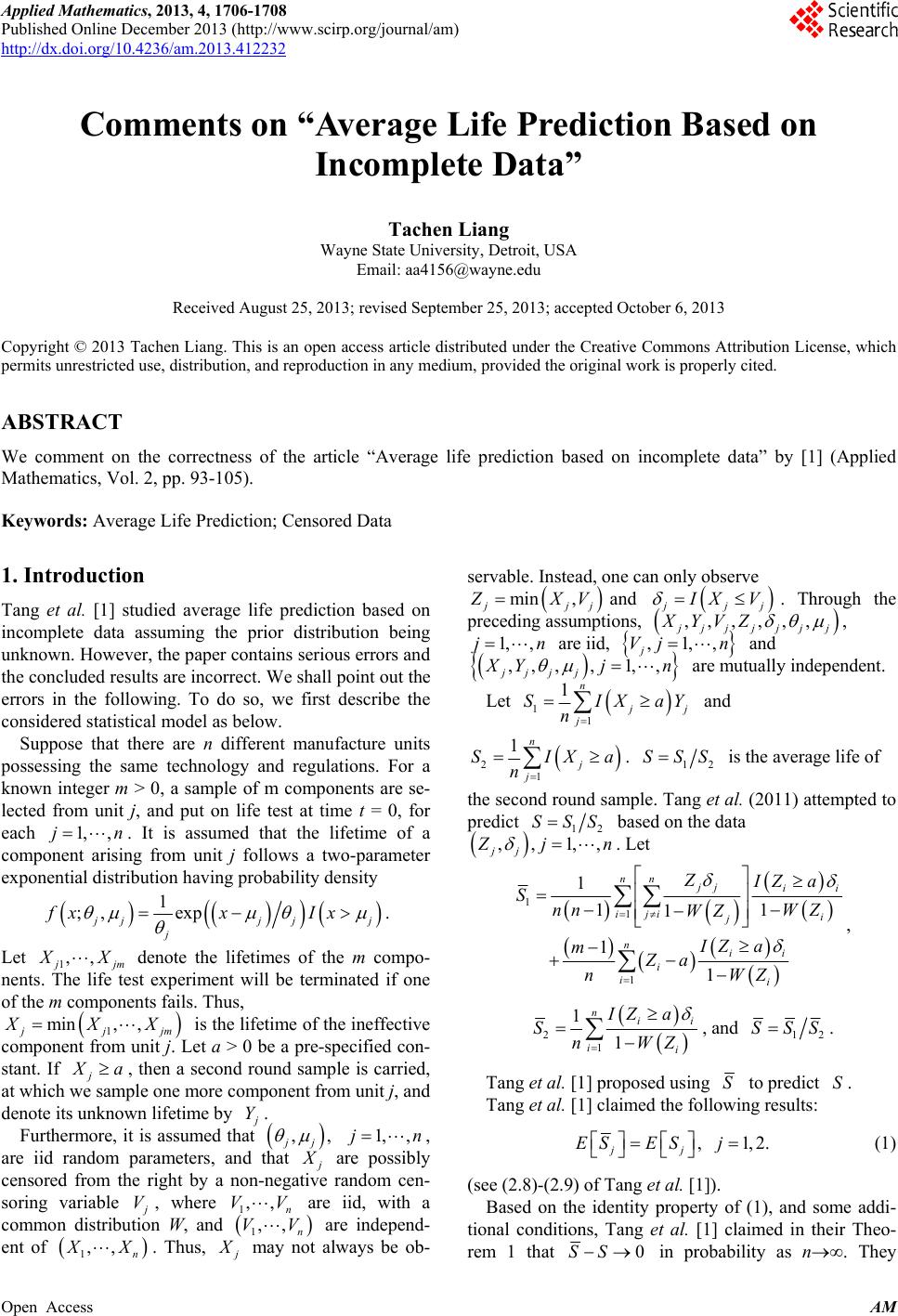
Applied Mathematics, 2013, 4, 1706-1708
Published Online December 2013 (http://www.scirp.org/journal/am)
http://dx.doi.org/10.4236/am.2013.412232
Open Access AM
Comments on “Average Life Prediction Based on
Incomplete Data”
Tachen Liang
Wayne State University, Detroit, USA
Email: aa4156@wayne.edu
Received August 25, 2013; revised September 25, 2013; accepted October 6, 2013
Copyright © 2013 Tachen Liang. This is an open access article distributed under the Creative Commons Attribution License, which
permits unrestricted use, distribution, and reproduction in any medium, provided the original work is properly cited.
ABSTRACT
We comment on the correctness of the article “Average life prediction based on incomplete data” by [1] (Applied
Mathematics, Vol. 2, pp. 93-105).
Keywords: Average Life Prediction; Censored Data
1. Introduction
Tang et al. [1] studied average life prediction based on
incomplete data assuming the prior distribution being
unknown. However, the paper contains serious errors and
the concluded results are incorrect. We shall point out the
errors in the following. To do so, we first describe the
considered statistical model as below.
Suppose that there are n different manufacture units
possessing the same technology and regulations. For a
known integer m > 0, a sample of m components are se-
lected from unit j, and put on life test at time t = 0, for
each . It is assumed that the lifetime of a
component arising from unit j follows a two-parameter
exponential distribution having probability density
1, ,jn
1
;, exp
jjj
j
fxxIx j
.
Let 1,,
jm
X
1
min ,
denote the lifetimes of the m compo-
nents. The life test experiment will be terminated if one
of the m components fails. Thus,
,
j
XXjm
is the lifetime of the ineffective
component from unit j. Let a > 0 be a pre-specified con-
stant. If j
X
a, then a second round sample is carried,
at which we sample one more component from unit j, and
denote its unknown lifetime by
Y.
Furthermore, it is assumed that
,,
jj
1, ,jn
,
are iid random parameters, and that
are possibly
censored from the right by a non-negative random cen-
soring variable
V, where V are iid, with a
common distribution W, and 1,,
n
V
,,
n
VV
1 are independ-
ent of
n1,,
X. Thus,
may not always be ob-
servable. Instead, one can only obser ve
min ,
jj
XVand
jj
XV
. Through the
preceding assumptions,
,,,,, ,
jj j
XYVZ jj j
,
1, ,jn
are iid,
,1,,Vj n
j and
,,,, ,
jjj j1,
Yj
n are mutually independent.
Let
11
1n
j
XaY
j
SI
n
and
a
21
1n
j
j
SIX
n
. 12
SSS
is the average life of
the second round sample. Tang et al. (2011) attempted to
predict 12
SSS
based on the data
,,1,,
jj
jn
. Let
11
11
1
ii
i
ii
i
IZ a
Snn WZ
a
m
Z
1
1
1
1
nn jj
iji j
n
i
i
Z
WZ
IZ
Za
nW
,
21
1
1
ni
ii
IZa
SnWZ
i
, and 12
SSS.
Tang et al. [1] proposed using S to predict . S
Tang et al. [1] claimed the following results:
, 1,2.
jj
ES ESj
(1)
(see (2.8)-(2.9) of Tang et al. [1]).
Based on the identity property of (1), and some addi-
tional conditions, Tang et al. [1] claimed in their Theo-
rem 1 that 0SS
in probability as n. They